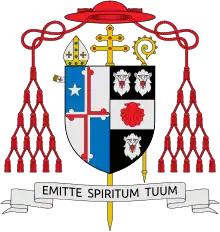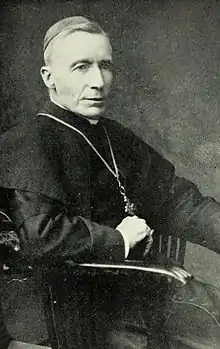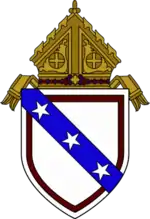James Gibbons
James Gibbons (July 23, 1834 – March 24, 1921) was an American prelate of the Catholic Church. He served as Apostolic Vicar of North Carolina from 1868 to 1872, Bishop of Richmond from 1872 to 1877, and as ninth Archbishop of Baltimore from 1877 until his death in 1921. Gibbons was elevated to the rank of cardinal in 1886.
James Cardinal Gibbons | |
|---|---|
| Cardinal, Archbishop of Baltimore | |
 | |
| See | Baltimore |
| Appointed | May 29, 1877 (coadjutor) |
| Installed | October 3, 1877 |
| Term ended | March 24, 1921 |
| Predecessor | James Roosevelt Bayley |
| Successor | Michael Joseph Curley |
| Other posts | Cardinal-Priest of Santa Maria in Trastevere |
| Orders | |
| Ordination | June 30, 1861 by Francis Kenrick |
| Consecration | August 15, 1868 by Martin John Spalding |
| Created cardinal | June 7, 1886 by Leo XIII |
| Rank | Cardinal- Priest |
| Personal details | |
| Born | July 23, 1834 Baltimore, Maryland |
| Died | March 24, 1921 (aged 86) Baltimore, Maryland |
| Previous post | Bishop of Richmond (1872–77) |
| Motto | Emitte spiritum tuum (Send forth your spirit) |
| Coat of arms |  |

Gibbons was consecrated a bishop August 16,1868, at the Baltimore Cathedral. The principal consecrator was Archbishop Martin J. Spalding. He was 34 years of age, serving as the first Apostolic Vicar of North Carolina. He attended the First Vatican Council, where he voted in favor of defining the dogma of papal infallibility. In 1872 he was named Bishop of Richmond by Pope Pius IX. In 1877, Gibbons was appointed Archbishop of Baltimore, the premier episcopal see in the United States. During his 44 years as Baltimore's archbishop, Gibbons became one of the most recognizable Catholic figures in the country. He defended the rights of labor, and helped convince Pope Leo XIII to give his consent to labor unions. In 1886, he was appointed to the College of Cardinals, becoming only the second cardinal in the history of the United States, after Archbishop John McCloskey of New York.
Early life and education
The fourth of six children, James Gibbons was born in Baltimore, Maryland,[1] to Thomas and Bridget (née Walsh) Gibbons. His parents were from Tourmackeady, County Mayo, Ireland, and settled in the United States after moving to Canada. After falling ill with tuberculosis in 1839, his father moved the family to his native Ireland, where he believed the air would benefit him. There, Thomas operated a grocery store in Ballinrobe and young James received his early education. His father died in 1847, and his mother returned the family to the United States in 1853, settling in New Orleans, Louisiana.[2]
Priesthood
Gibbons decided to pursue Holy Orders after attending a sermon given by Paulist co-founder, Clarence A. Walworth. In 1855, he entered St. Charles College in Ellicott City. After graduating from St. Charles, he entered St. Mary's Seminary in Baltimore in 1857. He suffered a severe attack of malaria during his time at St. Mary's, leaving his state of health so poor that his superiors almost considered him unsuitable for ordination. Slight of build and a little less than average height, from the early days of his priesthood he suffered from a sensitive stomach and consequent periods of nervous exhaustion. On June 30, 1861, Gibbons was ordained to the priesthood by Archbishop Francis Kenrick of Baltimore at the Baltimore Cathedral.[2]
He then served as a curate at St. Patrick's Church in Fells Point for six weeks before becoming the first pastor of St. Brigid's Church[3] in Canton. In addition to his duties at St. Brigid's, he assumed charge of St. Lawrence Church (now called Our Lady of Good Counsel Church) in Locust Point and was a chaplain for Fort McHenry in the Civil War.[2]
In 1865, Gibbons was made private secretary to Archbishop Martin John Spalding.[1] He helped prepare for the Second Plenary Council of Baltimore in October 1866. At Spalding's prompting, the Council fathers recommended both the creation of an apostolic vicariate for North Carolina and the nomination of Gibbons to head it.[4]
Episcopal career

On March 3, 1868, Gibbons was appointed the first Apostolic Vicar of North Carolina and Titular Bishop of Adramyttium by Pope Pius IX.[5] He received his episcopal consecration on the following August 15 from Archbishop Spalding, with Bishops Patrick Neeson Lynch and Michael Domenec, CM, serving as co-consecrators. This ordination, like his priestly ordination, also occurred at the Baltimore Cathedral. At age 34, he was one of the youngest Catholic bishops in the world and was known as "the boy bishop."
His vicariate, the entire state of North Carolina, had fewer than seven hundred Catholics. In his first four weeks alone in North Carolina, Gibbons traveled almost a thousand miles, visiting towns and mission stations and administering the sacraments. He also befriended many Protestants, who greatly outnumbered Catholics in the state, and preached at their churches. Gibbons made a number of converts, but finding the apologetical works available inadequate for their needs, he determined to write his own; Faith of Our Fathers[1] would prove the most popular apologetical work written by an American Catholic.[4]
Gibbons became a popular American religious figure, gathering crowds for his sermons on diverse topics that could apply to Christianity as a whole. He was an acquaintance of every president from Andrew Johnson to Warren G. Harding and an adviser to several of them.
From 1869 to 1870 Gibbons attended the First Vatican Council in Rome. Aged 35 years and 4 months when the Council opened, he was the youngest American bishop present by a mere six days (the second youngest was Jeremiah Francis Shanahan, Bishop of Harrisburg) and the second youngest in all (Basilio Nasser, Melkite Bishop of Baalbek, Lebanon, was more than five years his junior, aged just 30 years and 3 months at opening). Gibbons voted in favor of the doctrine of papal infallibility. He assumed the additional duties of Apostolic Administrator for the Diocese of Richmond, Virginia, in January 1872.
Gibbons was later named the fourth Bishop of Richmond on July 30, 1872. He was installed as Bishop on October 20, and served there until May 1877, when he was named Coadjutor Archbishop of Baltimore. He succeeded as Archbishop that October on the death of Archbishop James Roosevelt Bayley.[4] For the first twenty years of his administration he had no auxiliary bishop, and thus through the repeated confirmation tours to all parts of his jurisdiction he came to know the priests and people very well.

On 7 June 1886 Gibbons was created a Cardinal Priest and on 17 March 1887 he was assigned the titular church of Santa Maria in Trastevere.[6] He was the second American cardinal after John McCloskey. Gibbons advocated the creation of The Catholic University of America and served as its first Chancellor[1] upon its creation in 1887. He was the first American cardinal to participate in a papal conclave, in 1903. He would have participated in the 1914 conclave but he arrived late.[7]
In 1899 Pope Leo XIII sent Gibbons an encyclical, known by its first words in Latin Testem benevolentiae nostrae ("Concerning New Opinions, Virtue, Nature and Grace, with Regard to Americanism"), condemning what was termed "Americanism".[8] This was prompted by the preface of the French translation of the Life of Isaac Hecker,[9] wherein the translator attributed certain opinions to the late Father Isaac Hecker. Members of the hierarchy in the United States assured the Pope that the opinions expressed were not those of Father Hecker, who had never countenanced any deviation from, or minimizing of, Catholic doctrines.
During World War I Cardinal Gibbons was instrumental in the establishment of the National Catholic War Council, and afterwards supported the League of Nations. Although initially opposed to women's suffrage, when the nineteenth amendment passed Gibbons urged women to exercise their right to vote "...not only as a right but as a strict social duty."[7]
James Cardinal Gibbons died on March 24, 1921, at the age of 86.[7]
Labor advocate
Gibbons advocated for the protection of labor, an issue of particular concern because of the many Catholics who were being exploited by the industrial expansion of America's urban East Coast at the turn of the century. He was once quoted as saying, "It is the right of laboring classes to protect themselves, and the duty of the whole people to find a remedy against avarice, oppression, and corruption."[10] Gibbons had a key role in the granting of papal permission for Catholics to join labor unions.[11]
Gibbons successfully defended the Knights of Labor, which had a significant Catholic membership, from papal censure, thereby winning a reputation as labor's friend. In fact, he deplored class consciousness and condemned industrial violence.
Belgian Controversy
The Congo Reform Association was founded in England for the purpose of raising opinion against the regime of Leopold II of Belgium and to compel reform of conditions. The matter was scheduled to be discussed in October at the thirteenth International Peace Congress in Boston. Since the king had not been invited to send a representative, his government asked Gibbons to help keep the question off the agenda. The cardinal wrote a letter saying said that it would be unfair since no representative of the Belgian government had been invited to present the king's case. His effort failed to prevent a discussion of the question and he did not escape criticism for his intervention. Gibbons responded "I fear, that this agitation against King Leopold's administration is animated partly by religious jealousy and partly by commercial rivalry."[7] His largely defensive stance on Leopold II gained the recognition of then-Pope Pius X.[12]
According to historian John Tracy Ellis, as Gibbons suggested, religious jealousy and commercial rivalry did play a part in the movement for reform, but the evidence still weighed heavily against the Belgian government as having been guilty of serious exploitation of the native population. Gibbons relied too much on the word of the king's government and intermittent reports from missionaries. "For one of the few times in Gibbons' long life, his normally keen judgment went astray and exposed him to the charge of partisanship and of ignorance of the facts governing an issue. The cardinal should have steered clear of the case."[7]
A less flattering account of Cardinal Gibbon’s involvement is given in Adam Hochschild’s King Leopold’s Ghost: "[King Leopold’s] representatives in Rome successfully convinced the Vatican that this Catholic king was being set upon by unscrupulous Protestant missionaries. A stream of messages in Latin flowed from the Holy See across the Atlantic to the designated Catholic point-man for Leopold in the United States, James Cardinal Gibbons of Baltimore. …Cardinal Gibbons believed that the Congo reform crusade was the work of “only a handful of discontented men…depending largely upon the untrustworthy hearsay of the natives.” He spoke out loudly for Leopold, who awarded him the Grand Cross of the Order of the Crown.[13]
Works
Part of Gibbons' popularity derived from the works he authored. The Faith of Our Fathers (1876) remains the most enduringly popular. Also widely read were Our Christian Heritage (1889), The Ambassador of Christ (1896),[1] Discourses and Sermons (1908), and A Retrospect of Fifty Years (1916). He contributed a number of essays to much-read journals such as the North American Review and Putnams' Monthly. He was also a contributor to the Catholic Encyclopedia.[5] His style was simple but compelling. Protestant Americans looked often to Gibbons for an explanation of the Catholic position on contentious issues.
In 1876 Gibbons published The Faith of Our Fathers: A Plain Exposition and Vindication of the Church Founded by Our Lord Jesus Christ .
In 1899, Gibbons granted the Imprimatur for the Challoner edition of the Douay-Rheims Bible.

See also
- Catholic Church in the United States
- Historical list of the Catholic bishops of the United States
- James Cardinal Gibbons Medal
- List of Catholic bishops of the United States
- Lists of patriarchs, archbishops, and bishops
- Papal infallibility
References
- Chisholm, Hugh, ed. (1911). . Encyclopædia Britannica. 11 (11th ed.). Cambridge University Press. pp. 936–937.
- ""His Eminence James Cardinal Gibbons", The Archdiocese of Baltimore". Archived from the original on 2015-09-09. Retrieved 2015-07-31.
- "St. Brigid's Church, Baltimore". Archived from the original on 2015-02-22. Retrieved 2009-03-25.
- Blog, McNamara's (2013-07-02). "Cardinal James Gibbons, Baltimore (1834-1921)". McNamara's Blog. Retrieved 2020-08-23.
- The Catholic Encyclopedia and its makers. New York: The Encyclopedia Press. 1917. p. 65.
 This article incorporates text from this source, which is in the public domain.
This article incorporates text from this source, which is in the public domain. - Acta Sanctae Sedis (PDF). XIX. 1886–87. p. 429. Retrieved 28 January 2021.
- Ellis, John Tracy. Life of James Cardinal Gibbons (abridged by Francis L. Broderick), The Bruce Publishing Company, 1963
- Smith, Michael Paul. "Isaac Thomas Hecker." The Catholic Encyclopedia Vol. 7. New York: Robert Appleton Company, 1910. 4 October 2015
- Pallen, Condé. "Testem Benevolentiae." The Catholic Encyclopedia Vol. 14. New York: Robert Appleton Company, 1912. 4 October 2015
- Andrew Glass. "Cardinal James Gibbons is born, July 23, 1834". POLITICO. Retrieved 2020-08-23.
- interview, A. U. S. Catholic (2015-09-01). "Catholic priests and the labor movement". U.S. Catholic magazine - Faith in Real Life. Retrieved 2020-08-23.
- Weisbord, Robert G. (2003). "The King, the Cardinal and the Pope: Leopold II's Genocide in the Congo and the Vatican". Journal of Genocide Research. 5 (1): 40. doi:10.1080/14623520305651. ISSN 1462-3528.
- p. 224
Further reading
- Ellis, John T., The Life of James Cardinal Gibbons Archbishop of Baltimore, 1834-1921 (1952)
- Shea, John Gilmary. The Hierarchy of the Catholic Church in the United States, (New York: The Office of Catholic Publications, 1886), 82-84.
- Will, Allen S., Life of Cardinal Gibbons (1922).
External links
| Wikimedia Commons has media related to James Gibbons. |
 Works written by or about James Gibbons at Wikisource
Works written by or about James Gibbons at Wikisource- Roman Catholic Archdiocese of Baltimore
Works
- Works by James Gibbons at Project Gutenberg
- Works by or about James Gibbons at Internet Archive
- Works by James Gibbons at LibriVox (public domain audiobooks)

- James Cardinal Gibbons (1876). The Faith of Our Fathers: A Plain Exposition and Vindication of the Church Founded by Our Lord Jesus Christ. John Murphy Company. via Google Books
- James Cardinal Gibbons (1889). Our Christian Heritage. J. Murphy and company. via Google Books
- James Cardinal Gibbons (1896). The Ambassador of Christ. John Murphy Company.
- James Cardinal Gibbons (1908). Discourses and Sermons. John Murphy Company.
- James Cardinal Gibbons (1916). A Retrospect of 50 Years. John Murphy Company. via Google Books
- Pastoral Letter of 1919
- Gibbons (August 1920): Preface for American Catholics in the war; National Catholic war council, 1917-1921
- Phayer, Michael (2008). Pius XII The Holocaust And The Cold War. Indiana University Press. pp. 2–3. ISBN 9780253349309.
Biographies
- Ellis, John Tracy (1963). Life of James Cardinal Gibbons. The Bruce Publishing Company. (in the one‑volume abridgment by Francis L. Broderick)
- "Library of Congress Biography".
- Will, Allen Sinclair (1911). Life of James, Cardinal Gibbons. J. Murphy Company.
- "His vocational timeline at Catholic Hierarchy".
- "Catholic Home Study Service Biography".
Movie footage
Photographs
- James Cardinal Gibbons (Catholic University Archives)
- Cardinal Gibbons (Maryland Historical Society)
- Cardinal Gibbons Day October 16, 1911 (MHS)
- Cardinal Gibbons & Theodore Roosevelt (MHS)
- Golden Jubilee Celebration at Basilica of the Assumption (MHS)
- Service in progress at Basilica (MHS)
- Cardinal Gibbons' Cortege passes Washington Monument (MHS)
| Catholic Church titles | ||
|---|---|---|
| Preceded by Erected |
Vicar Apostolic of North Carolina March 3, 1868 – May 20, 1877 |
Succeeded by Stanislao Marco Gross |
| Preceded by Vincenzo Cima |
Titular Bishop of Adramyttium March 3, 1868 – July 30, 1872 |
Succeeded by Louis-Taurin Cahagne, O.F.M.Cap. |
| Preceded by John McGill |
Bishop of Richmond July 30, 1872 – May 20, 1877 |
Succeeded by John Joseph Keane |
| Preceded by Wincenty Lipski |
Titular Bishop of Ionopolis May 29 – October 3, 1877 |
Succeeded by Francis Xavier Leray |
| Preceded by James Roosevelt Bayley |
Archbishop of Baltimore October 3, 1877 – March 24, 1921 |
Succeeded by Michael Joseph Curley |
| Preceded by Lorenzo Nina |
Cardinal-Priest of Santa Maria in Trastevere March 17, 1887 – March 24, 1921 |
Succeeded by Giovanni Tacci Porcelli |

